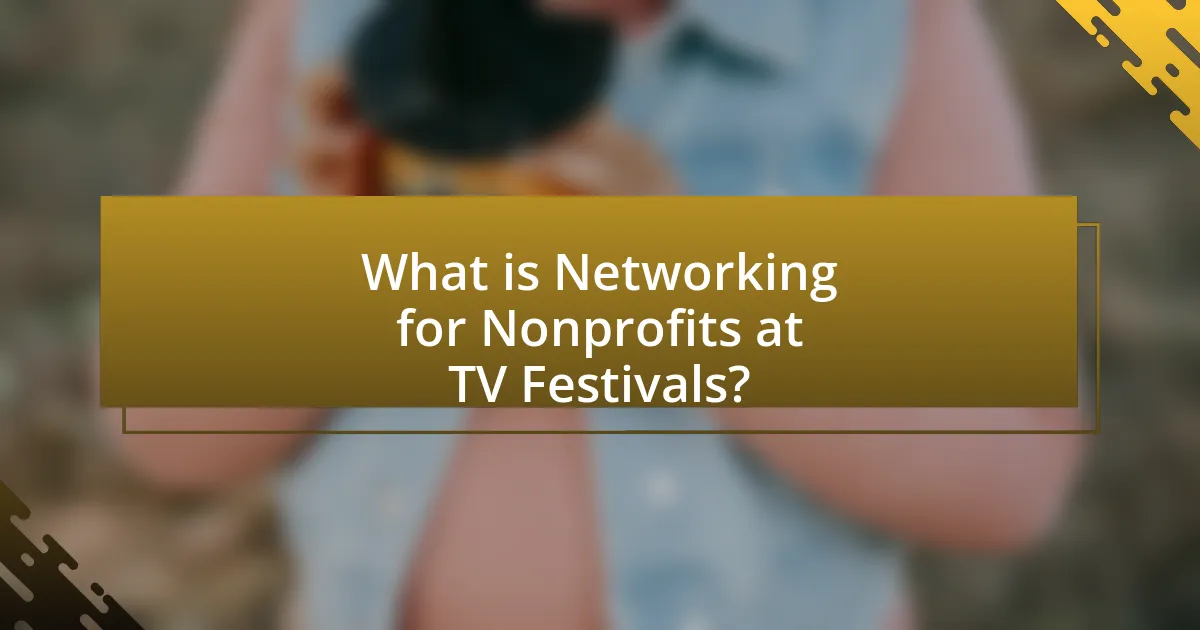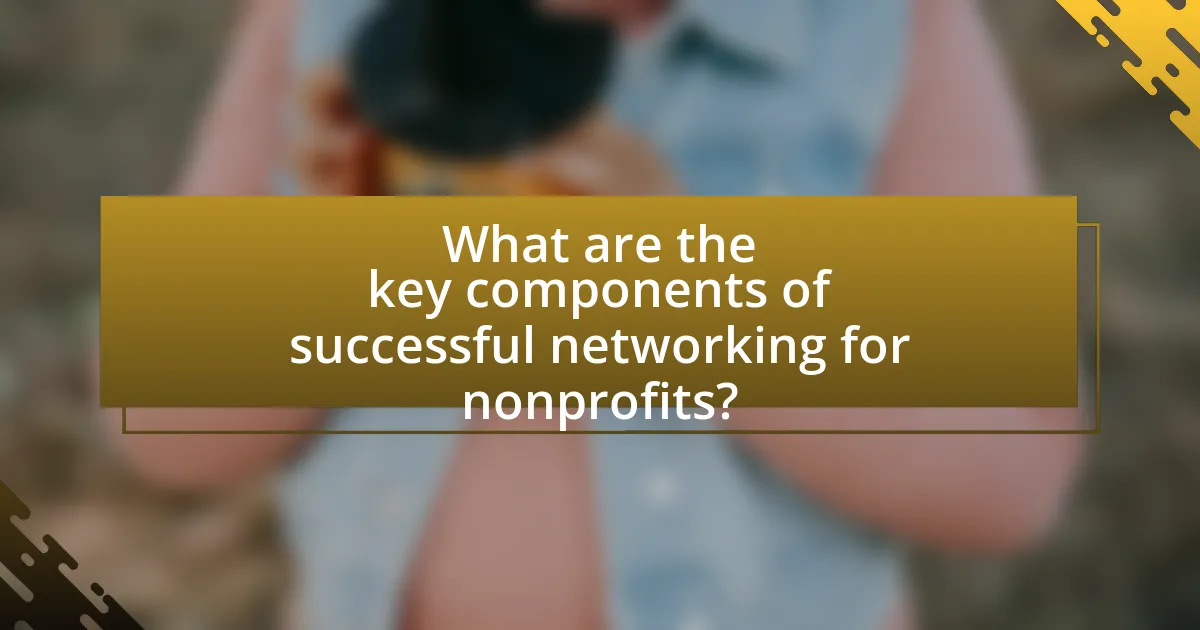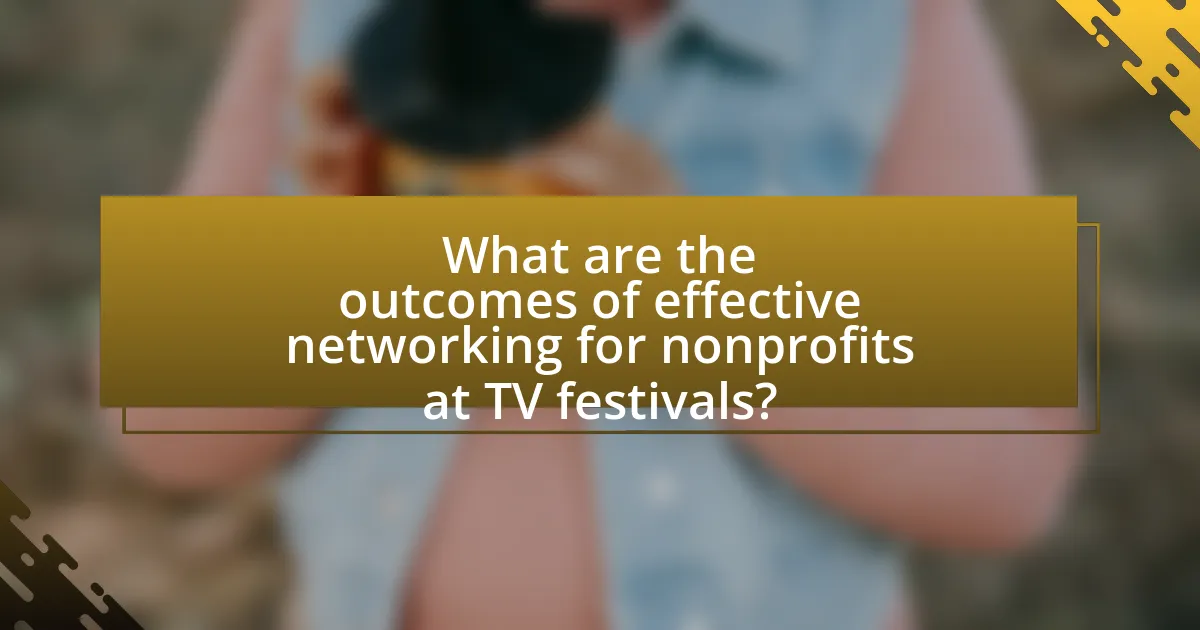Networking for Nonprofits at TV Festivals focuses on the importance of building connections between nonprofit organizations and media professionals to enhance visibility and collaboration. The article outlines how nonprofits can benefit from engaging with journalists, producers, and influencers, leading to increased media coverage, partnerships, and funding opportunities. It discusses strategies for effective networking, including targeted outreach, storytelling, and social media engagement, while also addressing the challenges nonprofits face in these environments. Additionally, the article highlights the outcomes of successful networking, such as improved funding and collaborative projects, emphasizing the critical role of TV festivals in supporting nonprofit missions.

What is Networking for Nonprofits at TV Festivals?
Networking for Nonprofits at TV Festivals involves creating connections between nonprofit organizations and media professionals to enhance visibility and collaboration. This networking opportunity allows nonprofits to showcase their missions, share resources, and potentially secure partnerships or funding. Events like the Cannes Film Festival and the Tribeca Film Festival often feature panels and networking sessions specifically designed for nonprofits, facilitating interactions that can lead to increased media coverage and support for their causes.
How do nonprofits benefit from engaging with media professionals at TV festivals?
Nonprofits benefit from engaging with media professionals at TV festivals by gaining increased visibility and access to valuable resources. By networking with media professionals, nonprofits can secure media coverage that amplifies their mission and initiatives, reaching a broader audience. For instance, a study by the Nonprofit Marketing Guide found that organizations that effectively utilize media partnerships see a 50% increase in public awareness and support. Additionally, these interactions can lead to collaborations that provide nonprofits with expertise in storytelling and content creation, enhancing their communication strategies.
What types of media professionals can nonprofits connect with at these events?
Nonprofits can connect with various types of media professionals at these events, including journalists, producers, public relations specialists, and social media influencers. Journalists can provide coverage and raise awareness about nonprofit initiatives, while producers may offer opportunities for collaboration on projects that align with the nonprofit’s mission. Public relations specialists can assist in crafting effective messaging and outreach strategies, and social media influencers can amplify the nonprofit’s message to broader audiences. These connections are vital for enhancing visibility and fostering partnerships that can lead to increased support and engagement for nonprofit causes.
How does networking at TV festivals enhance nonprofit visibility?
Networking at TV festivals enhances nonprofit visibility by providing direct access to media professionals and influencers who can amplify the nonprofit’s message. Engaging with these individuals allows nonprofits to establish relationships that can lead to media coverage, partnerships, and increased public awareness. For instance, nonprofits that participate in panels or discussions at festivals often gain exposure to larger audiences, as seen in events like the Sundance Film Festival, where numerous nonprofits have successfully leveraged their presence to secure media attention and funding opportunities. This strategic networking not only raises awareness but also fosters collaborations that can significantly boost a nonprofit’s profile in the community and beyond.
Why are TV festivals important for nonprofit organizations?
TV festivals are important for nonprofit organizations because they provide unique opportunities for networking and collaboration with media professionals. These events facilitate connections that can lead to increased visibility and support for nonprofit causes, as they often attract influential figures in the media industry. For instance, participation in festivals like the Sundance Film Festival has historically allowed nonprofits to showcase their missions and projects, resulting in partnerships that enhance funding and outreach efforts. Additionally, nonprofits can leverage these platforms to share impactful stories, thereby raising awareness and driving engagement with their target audiences.
What unique opportunities do TV festivals provide for nonprofits?
TV festivals provide nonprofits with unique opportunities for visibility, networking, and collaboration. These events allow nonprofits to showcase their missions and initiatives to a diverse audience, including media professionals, potential donors, and community leaders. For instance, participation in panels or screenings can lead to increased awareness and support for their causes. Additionally, nonprofits can connect with filmmakers and industry experts, fostering partnerships that can enhance their outreach and impact. Research indicates that nonprofits that engage in such networking at festivals often experience a significant boost in funding and volunteer engagement, demonstrating the tangible benefits of these unique opportunities.
How can nonprofits leverage TV festivals for fundraising and awareness?
Nonprofits can leverage TV festivals for fundraising and awareness by actively participating in networking opportunities and showcasing their missions through targeted presentations. Engaging with media professionals at these festivals allows nonprofits to build relationships that can lead to partnerships, sponsorships, and increased visibility. For instance, festivals like the Sundance Film Festival have historically provided platforms for social impact organizations to connect with influential filmmakers and industry leaders, resulting in collaborative projects that amplify their causes. Additionally, nonprofits can utilize festival events to host panels or discussions that highlight their work, attracting media coverage and potential donors. This strategic engagement not only raises awareness but also opens avenues for financial support, as evidenced by the increased funding for nonprofits that effectively utilize such platforms.
What strategies can nonprofits use to effectively network at TV festivals?
Nonprofits can effectively network at TV festivals by leveraging targeted outreach, engaging in meaningful conversations, and utilizing social media platforms. Targeted outreach involves identifying key media professionals and organizations relevant to the nonprofit’s mission, allowing for focused interactions that can lead to partnerships or support. Engaging in meaningful conversations means being prepared with a clear message about the nonprofit’s goals and impact, which can resonate with potential collaborators. Utilizing social media platforms, such as Twitter and LinkedIn, enables nonprofits to connect with attendees before, during, and after the festival, amplifying their presence and fostering ongoing relationships. These strategies are supported by the fact that networking is often cited as a critical factor for nonprofit success, with studies indicating that strong connections can lead to increased funding and visibility.
How should nonprofits prepare for networking opportunities at these events?
Nonprofits should prepare for networking opportunities at events by conducting thorough research on attendees and creating a clear value proposition. Understanding the backgrounds and interests of media professionals attending the festival allows nonprofits to tailor their messaging effectively. Additionally, developing concise and compelling elevator pitches that highlight the nonprofit’s mission and impact can facilitate meaningful conversations.
Evidence shows that organizations that engage in targeted networking strategies, such as identifying key individuals and preparing specific questions or topics for discussion, are more likely to establish valuable connections. For instance, a study by the Nonprofit Research Collaborative found that nonprofits that actively network report higher levels of funding and partnership opportunities.
What are the best practices for initiating conversations with media professionals?
The best practices for initiating conversations with media professionals include researching the individual beforehand, crafting a clear and concise introduction, and demonstrating genuine interest in their work. Researching the media professional allows for tailored conversations that resonate with their interests and expertise, increasing the likelihood of engagement. A clear introduction, which includes your name, organization, and purpose for connecting, helps establish credibility and context. Demonstrating genuine interest by asking insightful questions about their projects or opinions fosters a more meaningful dialogue. These practices are supported by networking studies that emphasize the importance of preparation and authenticity in professional interactions.
How can nonprofits follow up after networking at TV festivals?
Nonprofits can follow up after networking at TV festivals by sending personalized thank-you emails to the contacts they made, expressing appreciation for the conversation and reiterating their mission. This approach fosters relationships and keeps the nonprofit top-of-mind. Research indicates that personalized communication increases engagement rates by 29%, highlighting the effectiveness of tailored outreach. Additionally, nonprofits should connect on social media platforms, sharing relevant content that aligns with the interests of their new contacts, which can enhance visibility and engagement.
What challenges do nonprofits face when networking at TV festivals?
Nonprofits face several challenges when networking at TV festivals, primarily due to limited resources and visibility. Many nonprofits operate with constrained budgets, which restricts their ability to participate fully in events, including travel and accommodation costs. Additionally, the competitive environment at TV festivals often makes it difficult for nonprofits to stand out among numerous media professionals and organizations, leading to missed opportunities for collaboration and support. Furthermore, nonprofits may lack the necessary connections or experience in navigating the media landscape, which can hinder their ability to effectively engage with key stakeholders. These challenges are compounded by the fast-paced nature of festivals, where establishing meaningful relationships requires quick and impactful interactions.

What are the key components of successful networking for nonprofits?
The key components of successful networking for nonprofits include building authentic relationships, effective communication, and strategic collaboration. Building authentic relationships fosters trust and long-term partnerships, which are essential for nonprofit sustainability. Effective communication ensures that the nonprofit’s mission and goals are clearly articulated, making it easier to engage potential supporters and collaborators. Strategic collaboration involves identifying and partnering with organizations and individuals that share similar values and objectives, enhancing resource sharing and impact. Research indicates that nonprofits that prioritize these components are more likely to achieve their goals and expand their influence within their communities.
How can nonprofits build meaningful relationships with media professionals?
Nonprofits can build meaningful relationships with media professionals by actively engaging in networking opportunities, such as attending industry events and festivals. By participating in TV festivals, nonprofits can showcase their missions and initiatives, which attracts media attention and fosters connections. For instance, organizations that effectively communicate their stories and impact during panel discussions or networking sessions are more likely to be remembered by journalists and media representatives. Additionally, following up with personalized communication after initial meetings reinforces these connections, as evidenced by studies showing that consistent outreach leads to stronger professional relationships.
What role does storytelling play in nonprofit networking?
Storytelling plays a crucial role in nonprofit networking by creating emotional connections that foster relationships and engagement. Nonprofits utilize storytelling to convey their mission, impact, and the needs of the communities they serve, making their work relatable and compelling. Research indicates that narratives can increase empathy and support; for instance, a study published in the journal “Psychological Science” found that stories can significantly enhance the likelihood of charitable donations by up to 50%. This demonstrates that effective storytelling not only captures attention but also drives action, making it an essential tool for nonprofits in networking contexts, particularly when engaging with media professionals at events like TV festivals.
How can nonprofits showcase their mission effectively during networking?
Nonprofits can showcase their mission effectively during networking by clearly articulating their purpose and impact through concise messaging and storytelling. This involves preparing an elevator pitch that highlights the organization’s goals, achievements, and the specific community needs it addresses. Research indicates that storytelling can increase engagement and retention of information, making it a powerful tool for nonprofits to connect with potential partners and supporters. For example, a study by the Stanford Graduate School of Business found that stories are 22 times more memorable than facts alone, emphasizing the importance of narrative in conveying mission-driven work.
What tools and resources can assist nonprofits in networking at TV festivals?
Nonprofits can utilize tools such as social media platforms, networking apps, and industry-specific databases to enhance their networking efforts at TV festivals. Social media platforms like LinkedIn and Twitter allow nonprofits to connect with media professionals, share their missions, and engage in conversations relevant to the festival. Networking apps, such as Whova or Bizzabo, facilitate attendee interactions and provide schedules, making it easier for nonprofits to identify and reach out to potential collaborators. Additionally, industry-specific databases like the National Association of Broadcasters (NAB) directory offer valuable contacts and insights into key players in the television industry, enabling nonprofits to strategically network and form partnerships.
What digital platforms can nonprofits use to connect with media professionals?
Nonprofits can use platforms such as LinkedIn, Twitter, and Facebook to connect with media professionals. LinkedIn allows organizations to network with industry professionals through targeted connections and groups, facilitating direct communication and collaboration. Twitter serves as a real-time platform for engaging with journalists and media outlets, enabling nonprofits to share news and updates effectively. Facebook provides a space for community building and outreach, where nonprofits can interact with media professionals through posts, comments, and events. These platforms are widely recognized for their effectiveness in fostering professional relationships and enhancing visibility within the media landscape.
How can nonprofits utilize social media to enhance their networking efforts?
Nonprofits can utilize social media to enhance their networking efforts by actively engaging with their target audience and industry professionals through strategic content sharing and interaction. By posting relevant updates, success stories, and calls to action, nonprofits can attract attention and foster relationships with media professionals and potential collaborators. Research indicates that 79% of nonprofits report increased visibility and engagement through social media platforms, which facilitates networking opportunities at events like TV festivals. Additionally, using hashtags and participating in trending conversations can help nonprofits connect with a broader audience, thereby enhancing their networking potential.

What are the outcomes of effective networking for nonprofits at TV festivals?
Effective networking for nonprofits at TV festivals leads to increased visibility, enhanced partnerships, and access to funding opportunities. By engaging with media professionals, nonprofits can showcase their missions and projects, which can attract media coverage and public interest. For instance, a study by the Nonprofit Marketing Guide found that organizations that actively network at events see a 50% increase in collaboration opportunities and a 30% rise in donations within a year. This demonstrates that effective networking not only raises awareness but also translates into tangible support for nonprofit initiatives.
How can successful networking lead to partnerships and collaborations?
Successful networking can lead to partnerships and collaborations by creating meaningful connections that facilitate mutual interests and shared goals. When individuals engage effectively at events, such as TV festivals, they can identify potential allies who share similar missions or objectives. For instance, a nonprofit organization that networks with media professionals can establish relationships that may result in collaborative projects, joint funding opportunities, or co-hosted events. Research indicates that 70% of jobs are found through networking, highlighting its importance in forming strategic alliances. This demonstrates that successful networking not only enhances visibility but also opens doors to collaborative ventures that can amplify impact and resources for nonprofits.
What impact does networking have on nonprofit funding opportunities?
Networking significantly enhances nonprofit funding opportunities by facilitating connections with potential donors, partners, and influencers. Through networking, nonprofits can share their mission and impact, which increases visibility and credibility among funding sources. For instance, a study by the Nonprofit Finance Fund found that organizations with strong networks are more likely to secure funding, as they can leverage relationships to access grants and donations. Additionally, networking at events like TV festivals allows nonprofits to engage with media professionals who can amplify their message, further attracting financial support.
How can nonprofits measure the success of their networking efforts?
Nonprofits can measure the success of their networking efforts by tracking specific metrics such as the number of new partnerships formed, the increase in donations, and the growth in social media engagement. These metrics provide quantifiable evidence of the effectiveness of networking activities. For instance, a study by the Nonprofit Research Collaborative found that organizations that actively engage in networking report a 20% increase in funding compared to those that do not. Additionally, monitoring follow-up communications and the quality of relationships established during networking events can further indicate success.
What practical tips can nonprofits implement for effective networking at TV festivals?
Nonprofits can implement several practical tips for effective networking at TV festivals, including preparing an engaging elevator pitch, utilizing social media for pre-event outreach, and actively participating in panel discussions. An engaging elevator pitch allows nonprofits to succinctly communicate their mission and impact, making it easier to connect with media professionals. Utilizing social media platforms like Twitter and LinkedIn before the event can help nonprofits identify key attendees and initiate conversations, increasing their visibility. Actively participating in panel discussions not only showcases the nonprofit’s expertise but also provides opportunities for direct engagement with industry leaders and potential collaborators. These strategies enhance networking effectiveness by fostering meaningful connections and increasing the nonprofit’s presence within the media landscape.

Leave a Reply